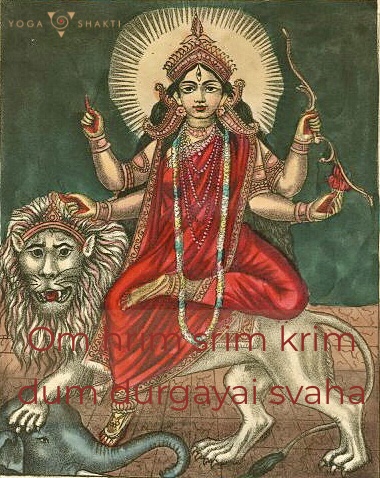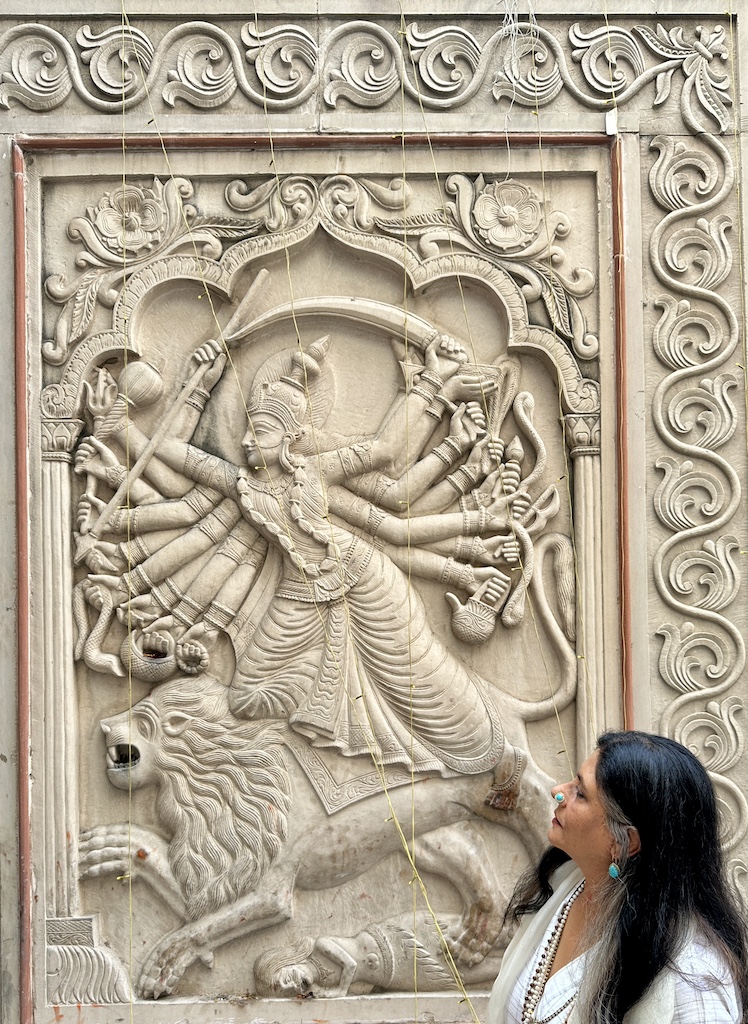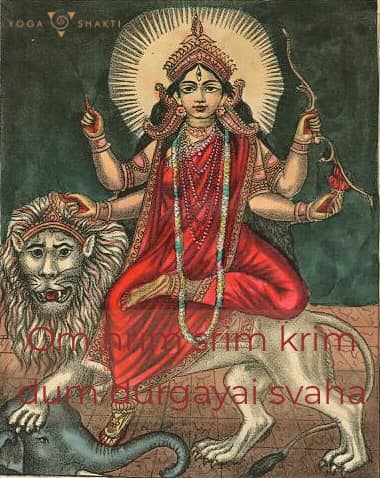
During the Navaratri or Nine days of Goddess worship women play a pivotal role in Shakti worship, connecting deeply to the essence of the Divine Feminine energy and grace.
Shakta Hindu traditions show that human life reaches its summit in the celebration of the Divine, of which the mother is the most endearing form.
Sadhakas perform sacred rituals, austerities, intense worship and celebrate in the fanfare of the Mother Goddess’s festivities.
Shakti, the Mother Goddess holds the key to universal healing and well-being and her worship encompasses all beings from all walks of life.
Navaratri is celebrated twice a year – ‘Chaitra’ or ‘Vasant Navaratri’ (March-April), and ‘Sharad Navaratri’ (October-November). Different parts of India honor the Devi in their own respective traditions.
April 26 Webinar With Yogini Shambhavi
https://www.yogaopenspace.com/event-details/awakening-the-intuitive-shakti-with-yogini-shambhavi
How to Worship Navaratri
- Sri Ganesha is always worshipped to remove all negativity, bestowing buddhi to achieve our sacred goals in life.
- First 3 days Maa Durga is honored, decimating all negativity and misfortune. Next 3 days Lakshmi Devi is worshipped willing both spiritual and worldly prosperity.
- The last 3 days Saraswati Devi is worshipped bestowing all learning and wisdom.
- In the North we worship Maa Kali through the first 3 days, working through the darkness of our karmas. We also worship the Nine forms of Maa Durga through the Navaratri.
Navaratri Vedic Astrological Significance
An important aspect of Navaratri celebrations is the Navagraha Shanti Puja, a propitiation of all the Nine Planets.
In the sacred text the Devi Mahatmya the story of Markandeya Purana Maa Durga was bestowed the grace of all the weapons by the Devata forces to fight the negative force of Mahisasura in her form as Chamunda Devi.
As a goddess, Maa Durga’s feminine power contains the energies of all the Devata. Each of her weapons was given to her by various Devata: Rudra’s trident, Vishnu’s discus, Indra’s thunderbolt, Brahma’s kamandalu, Kuber’s Ratnahar.
After 9 days of aggression Maa Durga emerged victorious on the tenth day which is celebrated as Dussehra or Vijaya Dashmi the triumphant victory of the Goddess.
Rahu energy signifies our worldly temptations and distractions. Rahu serves us the higher purpose of grounding in our spiritual self through discrimination and sadhana. The Navaratri is the best time to tame this Rahu force with the Durga Raksha mantra.
The Nine days of Shakti worship symbolize dealing with our own samsaric karmas of worldly maya. Connecting with the deeper potential of the Mother Goddess we spiritualize our lives seeking out the higher self.
Navaratri Celebration
Awakening early one moves through the rituals of cleansing and decorating the home and preparing for the rites. One must maintain a sattvic lifestyle of vegetarian food, celibacy and prayer offerings to the Goddess.
One of the observances during Navaratri is the Akhand Jyot or ghee lamp which is kept lit continuously for nine days. The light represents the Shakti force which permeates the home and the jiva or embodied soul unfolding purity and divine consciousness.
One usually fasts during these Nine days, taking one meal at sunset of particular sattvic food.
Navadurga or Nine Manifestations of Maa Durga
Shakti manifests as Nine forms of Goddess Durga representing Her various attributes.
- ‘Sri Shailaputri’- daughter of the Himalayas yielding steadfastness
- ‘Sri Brahmacharini’– personifying purity, deep love and shraddha
- ‘Sri Chandraghanta’– who holds the power and soma of the Moon
- ‘Sri Khusmanda’– unfolds bliss, happiness and well-being
- ‘Sri Skandamata’- Mother of Skanda, she personifies eternal fire
- ‘Sri Katyayani’– the power of transformation as the aspect of Ma Kali
- ‘Sri Kalaratri’– destroyer of darkness and ignorance.
- ‘Sri Mahagauri’– bestower of purity and endless virtues
- ‘Sri Siddhidatri’ – bestowal of all accomplishments, spiritual powers and knowledge.
Durga Sankalpa Shakti
When lighting the akhand jyot offer a flower and make a sankalpa for universal peace, strength and love…..this encompasses our personal wish as well. Following the sankalpa chant the Durga Mantras and Durga Gayatri.

Navaratri Puja
All offerings and prayer with deep shraddha (conscious faith) and reverence paves the way for the Devi’s benevolence and divine grace. In my book Yogini Unfolding the Goddess Within my experiences during the Navaratri are shared, as well as explanations on revering the Devi and celebrating the Navaratri.
Creating a sacred space with placing murtis or icons of Ma Durga, Shri Ganesha and Lord Shiva, the Durga Saptashati, pomegranate, coconut, roli (red color for tilak), moli (red sacred thread), chawal (rice), paan (betel leaves), supari (beetle nuts), cloves, cardamom, kumkum (vermilion) and gulal. One must bathe before beginning the puja.
Ghatasthapana – For the puja we place a Kalasha, the clay or metal pot filled with water and decorate it with a coconut and Mango or betel nut leaves. Tie the moli or red thread around its mouth. We may also place a ghee lamp inside the kalash.
Akhandjyot – Lighting a ghee lamp constantly through the nine nights and days. This takes a lot of nurturing, shraddha, deep faith, vigilance, concentration and alertness. The flame represents the presence of Shakti so we ensure She is ever present. Staying awake at night unfolds many spiritual experiences.
Offer red flowers, rice, pomegranate and two sticks of incense to the Goddess. Offer her the Arati with mantras or her sacred verses.
Hariyali – Navaratri marks the symbolism of fertility and auspiciousness with the nurturing of the ‘Hariyali’, where barley seeds are planted in a clay pot and closely nurtured every day through the nine days. My hariyali would sprout to over two feet high. After the nine days this pot is offered at the temple or into flowing waters.
Lalita Panchami or the fifth day it is customary to seek the blessings of Shri Saraswati by offering all the books within the house before a sacred lamp and invoke the blessings of Saraswati. Artisans lay down their tools before the goddess and seek her blessings for their work.
Kanchika Pujan or Kumari Puja – During the Navaratri young girls are worshipped for nine consecutive days, offering them meals. A nubile girl symbolizes the unmanifest pure Shakti which we must revere to draw into our own consciousness. On the last day of the Navaratri we invite 9 young girls and revere them with washing their feet, offering them prasada and giving them a token.
Naivedya – Offering consecrated food to the Goddess. During Navaratri we prepare sattvic, pure food dishes for the Goddess, as is customary. Singhare ka Atta, kuttu ka Atta or buckwheat flour is used to prepare rotis or puris, for the fast. Food is prepared with broken rice, yellow lentils, sago and potatoes during the fast. Spices are restricted to red chillies, turmeric, cumin seeds and rock salt is used for cooking. All fruits and foodstuff made of fruits are eaten during the seven days. Vegetables used are pumpkin, potatoes, cabbage. One may drink beverages like tea, coffee and milk during the Navaratri.
On Ashtami, the eighth day we end our fast by worshipping 9 young girls with washing their feet and offering prasad. As per the tradition, puris (deep fried Indian bread), halwa (sweet dish made of suji) and Bengal gram made dry are served to the young girls. In some instances the fast is ended on the 9th day.

Mantras For Navaratri
Om hrim srim krim dum Durgayai svaha
Om Girijayai Vidmahe Shivapriyayai Dhimahi
Tanno Durga Pracodayat
Ya devi sarva bhutesu, matra rupena sansthita
Ya devi sarva bhutesu, shakti rupena sansthita
Ya devi sarva bhutesu, shanti rupena sansitha
Namastasyai, namastasyai, namastasyai, namo namaha!
Sarva mangala maangalye shive sarvaartha saadhike
Sharanye trayambake Gauri
Narayani namostute
Annapoorne sadapoorne shankarah praanavallabhe
Njana vairaagya sidhyardham bhikshaam dehi cha parvati
Navagraha Shanti Mantra
Om suryadi navagraha devatabhyo namo namah
Om shanti shanti shantih
कम देखें






